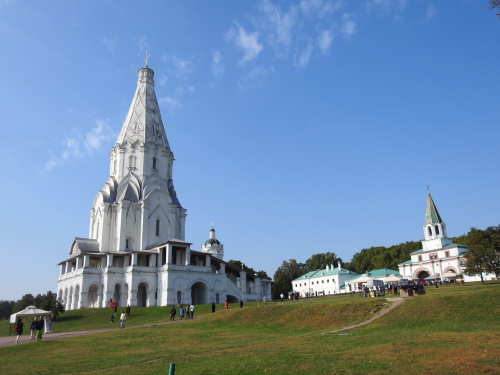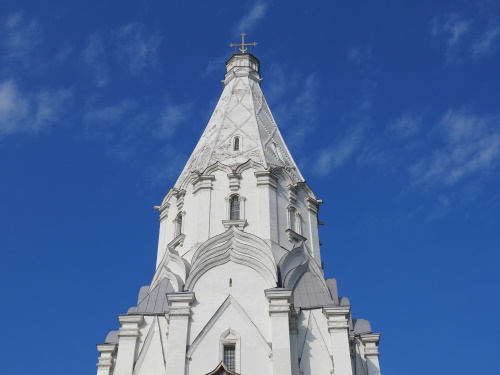Blog WHS Visits
WHS #718: Church of the Ascension
The Church of the Ascension in the Moscow suburb of Kolomenskoye was the first stop on my two-week trip across Russia. It is a relatively minor sight in this historic capital: when you look at any of those ‘Top Ten Things do in Moscow’-things, the Kremlin and Red Square, the Metro and the Novodevichy Convent will surely be in there. The Kolomenskoye Estate however will only turn up in longer lists of attractions or not at all. That does not mean that it is quiet however: when I visited on a Sunday morning around 9 a.m., several Chinese tour groups were already present too.
The site has been registered as a Single Monument without a Buffer Zone, so it’s all about this one ‘White Column’. Part of the compound are also a freestanding bell tower, the colourful entrance gate and what looks like the remains of another gate. There is no entrance fee, although you can get tickets to enter ‘six museums’ from the on-site kiosk. The tickets were free, I don’t know if they always are or because it was a special day today (‘Moscow Day’).
One of the six museums actually is the interior of the Church of the Ascension. It is not in religious use anymore and now hosts a small exhibition on its architecture. There are two reasons to enter: to get a feel for how tiny it is inside ánd to see its original brick colouring. One of the distinguishing features of the Church as we now know it is its white colour: but the walls were only whitewashed leading up to the 1980 Olympic Games. When you look closer, the bricks become visible. Gathered from a photo shown inside the church, the original colouring was a red brick roof and greyish-blueish main structure.
Another museum is the ‘Kolomenskoye museum’. Its entrance is in the small building to the right of the entrance gate, standing with your back to the church. This looks like a minor thing seen from the outside, but the exhibition space actually goes all the way across the main gate to the other side. It spans 2 floors and a cellar.
I was really glad that I decided to enter – while the tourist masses covered the field around the church, almost no one visited this museum. It felt a bit stiff at first – with in each room a stern looking Russian lady keeping watch – but there are several good icons on show and other memorabilia from the former Royal Estate.
During the preparation of my visit, I noticed that the ICOMOS evaluation text suggests that originally the whole Kolemenskoye Estate was nominated 2 years earlier. It then was revised into this narrow scope for inclusion in 1994. Besides this hint in the AB evaluation I have not been able to find further evidence whether this indeed was the case. The former Royal Estate now is kind of an open air museum of wooden buildings, brought there from other places in the country. It has a lovely setting along the Moskva river and is a pleasant place for a lazy Sunday morning, but the Church of the Ascension really is the only exceptional building here.
Els - 8 september 2019
Comments
Els Slots 10 September 2019
Thanks for the research, Solivagant! I will update the site history of each of the 3 individual WHS.
Solivagant 9 September 2019
@Els "I noticed that the ICOMOS evaluation text suggests that originally the whole Kolemenskoye Estate was nominated 2 years earlier. It then was revised into this narrow scope for inclusion in 1994. Besides this hint in the AB evaluation I have not been able to find further evidence whether this indeed was the case."
Indeed it was. The July 1992 Bureau in Paris reported that "it deferred examination of this nomination to allow the competent Russian authorities to reformulate the proposal so as to include only the Ascension Church. Furthermore the Bureau requested that the new nomination comprises detailed documentation concerning the authenticity of the property".
Presumably this was done on the basis of the ICOMOS evaluation, but we have no detail as to why ICOMOS was against including the entire Estate.
The original Nomination was Ref 634 and was titled "Architectural, archaeological and natural ensemble of Kolomenskoye". The revised nomination in 1994 was given Ref 634rev and was titled simply "The Church of the Ascension, Kolomenskoye. The original title might imply that the site was originally nominated to include Natural values - but there is no evidence that this was the case since it appears solely in the "Cultural nomination" list.
At that same Bureau, however, the Solovetskiy Islands WERE nominated as a "Mixed" site titled "Cultural and natural historic ensemble of the Solovetskiy Islands" , This shared nomenclature to include the word "Natural" seems strange when one use was, apparently, NOT as a mixed site and the other WAS! In fact the Solovetskiy Islands were REferred simply with the request for the "competent Russian authorities to reconsider the title of this property which could be modified as follows " Cultural and historic ensemble of Solovetskiy" In fact the word "Islands" was retained. Despite the documents labelling it as a "mixed" nomination it doesn't appear that it was ever evaluated as such since ICOMOS stated " It is of the opinion that the word "natural" should
be removed from the title, since the historical and cultural importance of Solovetskii far outweighs its natural interest. It recommends that IUCN be requested to consider this aspect of the site." - it never did!! In fact it was sorted out in time for the WHC in Dec 2012 so a formal "Referral" never took place.
However our "history" for 3 Russian nominations that year are incomplete
a. Kolomenskoye was DEFerred" from 1992 to 1994
b. Solovetskiy was nominated in 1992 as a mixed site and was recommended for a REferral but a name change got it inscribed in 1992
c. Vladimir and Suzdal were nominated in 1992 separately as "Monuments of Vladimir" and "Monuments of Vladimir" with separate Ref Nos. A DEferral was recommended at the Bureau to bring them together but this too was sorted out by the time of the 1992 WHC!!


